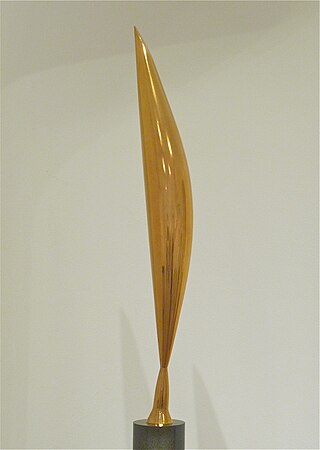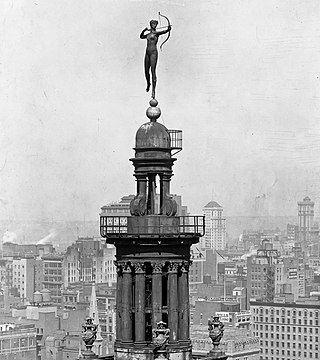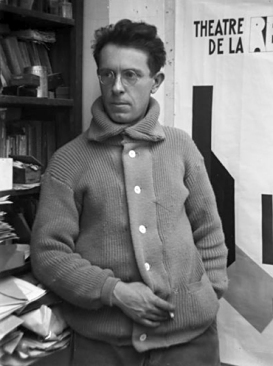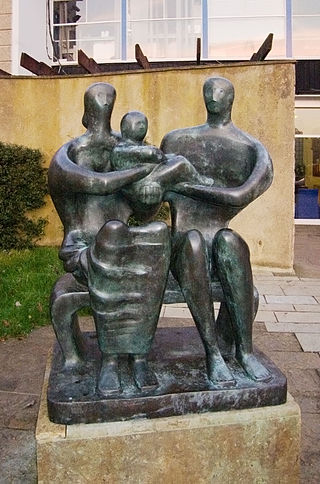
Edgar Degas was a French Impressionist artist famous for his pastel drawings and oil paintings.

Sir Jacob Epstein was an American-British sculptor who helped pioneer modern sculpture. He was born in the United States, and moved to Europe in 1902, becoming a British subject in 1910.

The Thinker is a bronze sculpture by Auguste Rodin, situated atop a stone pedestal. The work depicts a nude male figure of heroic size sitting on a rock. He is seen leaning over, his right elbow placed on his left thigh, holding the weight of his chin on the back of his right hand. The pose is one of deep thought and contemplation, and the statue is often used as an image to represent philosophy.

Gaston Lachaise was a French-born sculptor, active in America in the early 20th century. A native of Paris, he is most noted for his female nudes such as his heroic Standing Woman. Gaston Lachaise was taught the fundamentals of European sculpture while living in France. While still a student, he met and fell in love with an older American woman, Isabel Dutaud Nagle, then followed her after she returned to America. There, he became profoundly impressed by the great vitality and promise of his adopted country. Those life-altering experiences clarified his artistic vision and inspired him to define the female nude in a new and powerful manner. His drawings, typically made as ends in themselves, also exemplify his remarkably new treatment of the female body.

Max Weber was a Jewish-American painter and one of the first American Cubist painters who, in later life, turned to more figurative Jewish themes in his art. He is best known today for Chinese Restaurant (1915), in the collection of the Whitney Museum of American Art, "the finest canvas of his Cubist phase," in the words of art historian Avis Berman.

Bird in Space is a series of sculptures by Romanian sculptor Constantin Brâncuși. The original work was created in 1923 and made of marble. This sculpture is also known for containing seven marble figures and nine bronze casts. Brancusi created the piece over 14 times and in several mediums over a period of 20 years. It was sold in 2005 for $27.5 million, at the time a record price for a sculpture sold in an auction. The original title in Romanian is Pasărea în văzduh.

The Little Fourteen-Year-Old Dancer is a sculpture begun c. 1880 by Edgar Degas of a young student of the Paris Opera Ballet dance school, a Belgian named Marie van Goethem.

Henry McBride was an American art critic known for his support of modern artists, both European and American, in the first half of the twentieth century. As a writer during the 1920s for the newspaper The New York Sun and the avant-garde magazine The Dial, McBride became one of the most influential supporters of modern art in his time. He also wrote for Creative Art (1928-1932) and Art News (1950-1959). Living to be ninety-five, McBride was born in the era of Winslow Homer and the Hudson River School and lived to see the rise of Jackson Pollock, Mark Rothko, and the New York School.

Renée Sintenis, née Renate Alice Sintenis, also known as Frau Emil R. Weiss, was a German sculptor, medallist, and graphic artist who worked in Berlin. She created mainly small-sized animal sculptures, female nudes, portraits, and sports statuettes. She is especially known for her Berlin Bear sculptures, which was used as the design for the Berlinale's top film award, the Golden Bear.
Elsa Fraenkel née Rothschild (1892–1975) was a German–born British sculptor raised in Heidelberg, Germany.
The Stettheimer Dollhouse is a two-story, twelve-room dollhouse, created by Carrie Walter Stettheimer (1869-1944) over the course of two decades, from 1916 to 1935. It contains miniature art made for the dollhouse by artists like Marcel Duchamp, Alexander Archipenko, George Bellows, Gaston Lachaise, and Marguerite Zorach.

Standing Woman is a heroic bronze statue of a confident, robust nude woman by Gaston Lachaise that was modeled in 1928-30 and first cast in bronze in 1933.

Diana – also known as Diana of the Tower – is an iconic statue by sculptor Augustus Saint-Gaudens, representing the goddess Diana. Once a major artistic feature of New York City, the second version stood atop the tower of Madison Square Garden from 1893 to 1925. Since 1932, it has been in the collection of the Philadelphia Museum of Art.

Joseph Brummer was a Hungarian-born art dealer and collector who exhibited both antique artifacts from different cultures, early European art, and the works of modern painters and sculptors in his galleries in Paris and New York. In 1906 he and his two brothers opened their first gallery in Paris, the Brummer Gallery. At the start of World War I, they closed the gallery and moved to New York City. Joseph alone opened his next gallery in 1921 in Manhattan.

The Modern Art Foundry is an historic foundry in Astoria, Queens, New York, founded in 1932 by John Spring. His descendants continue to operate the business in what used to be the carriage house of the Steinway Mansion.

Joseph Csaky was a Hungarian avant-garde artist, sculptor, and graphic artist, best known for his early participation in the Cubist movement as a sculptor. Csaky was one of the first sculptors in Paris to apply the principles of pictorial Cubism to his art. A pioneer of modern sculpture, Csaky is among the most important sculptors of the early 20th century. He was an active member of the Section d'Or group between 1911 and 1914, and closely associated with Crystal Cubism, Purism, De Stijl, Abstract art, and Art Deco throughout the 1920s and 1930s.

The Rearing Horse and Mounted Warrior or Budapest horse is a bronze sculpture attributed to Leonardo da Vinci. Depicting Francis I of France on a destrier horse, it is estimated to have been cast from a clay or wax model in the first half of the 16th century. The sculpture is in the permanent exhibit of the Budapest Museum of Fine Arts.

Family Group is a sculpture by Henry Moore. It was his first large-scale bronze sculpture, and his first large bronze with multiple castings. Made for Barclay School in Stevenage, it evolved from drawings in the 1930s, through a series of models to bronze castings in 1950–51. It also one of the last important sculptures that Moore developed from preliminary drawings: in future, he worked mainly from found objects, maquettes and models.
Gerald Nordland (1927–2019) was an American museum director and art critic.
Isabel Dutaud Nagle Lachaise (1872–1957) was an American-born poet, and wife of sculptor Gaston Lachaise active in the early 20th century. Isabel Lachaise was his muse, model and the inspiration for many of his sculptures and drawings.
















